Clematis Niobe - variety description
Large-flowered clematis Niobe is an achievement of Polish selection. It was withdrawn in 1975. The plant belongs to the Zhakman group and is suitable for growing in all regions of our country. Consider the characteristics of the variety, the rules for planting and leaving.
- Description of the plant
- Landing features
- Site selection and preparation
- Selection and preparation of seedlings
- Landing technique
- Care requirements
- Watering
- Loosening and mulching
- Top dressing
- Pruning
- Preparing for winter
- Reproduction methods
- Stem layering
- By dividing the rhizome
- Cuttings
- Diseases and pests
- Application in design
- Variety reviews
- Useful videos
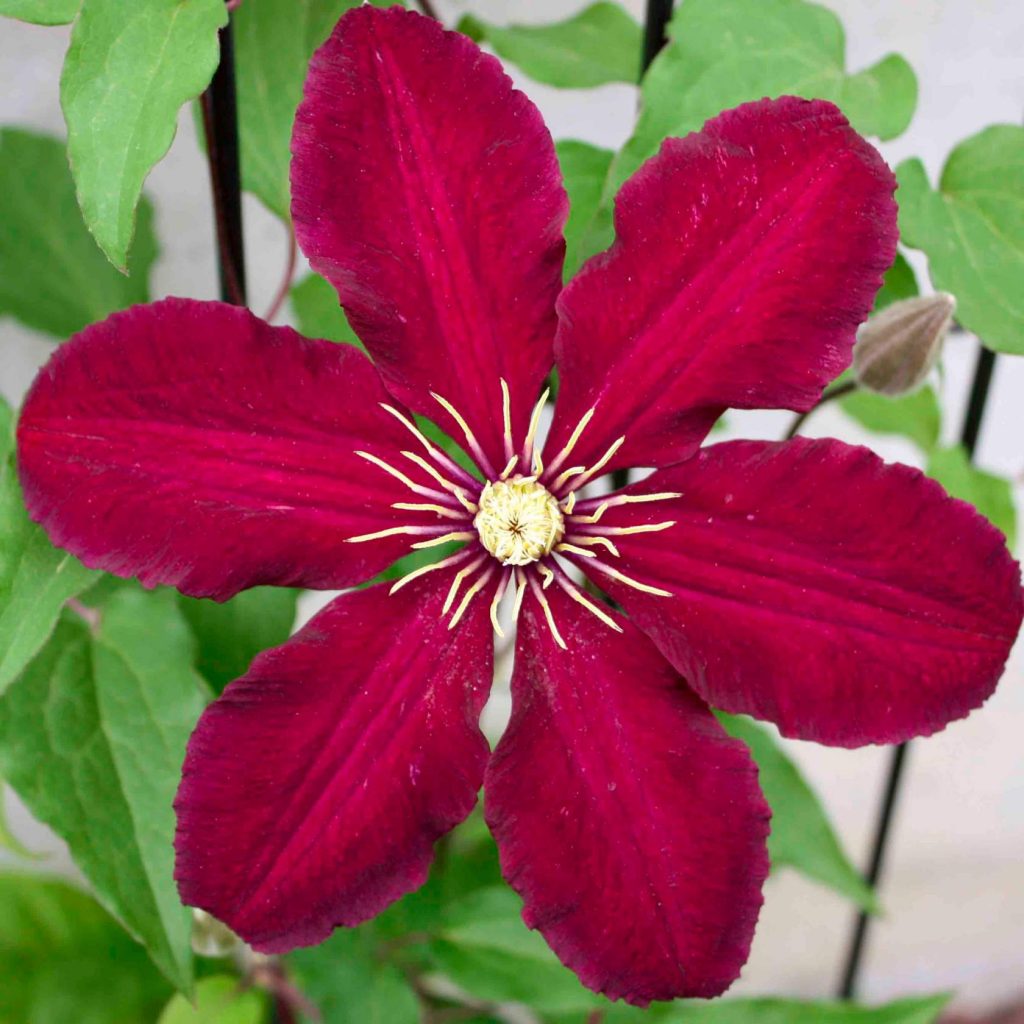
Clematis niobe description
Description of the plant
The botanical name is clematis Niobe. You can distinguish this perennial culture by the following description:
- shrub vine with climbing stems up to 2.5 m long;
- blooms in large inflorescences, 10-15 cm in diameter;
- petals with a velvety surface, burgundy with a bright yellow center;
- buds are formed on the shoots of the current year.
Flowering, depending on the growing region, occurs at different times:
- in the middle lane - from July to September;
- in the southern zone - from August to October.
Landing features
To grow a beautiful and luxuriantly flowering shrub, you need to plant it on time in fertile land and in a suitable place.
Clematis is planted in the spring, when the soil warms up to 10-12 ° C and the last frosts pass.
Gardeners of the south are planted not only in spring, but also in autumn - in the first half of September. So the seedlings have time to take root, adapt in a new place and prepare for the upcoming wintering.
Site selection and preparation
It is a sun-loving crop that prefers to grow in a windless area with deep groundwater. Optimum depth - 2-2.5 m
The soil is suitable light, with good drainage, a high content of organic and mineral components.
Clematis grows poorly on acidified soil. The optimal indicator is 6-7 units. If it exceeds the norm, the place for planting is sprinkled with dolomite flour, chalk, calcite or slaked lime - 400 g / m².
The plot is prepared a month before disembarkation - garden debris, plant residues are removed, dug up and leveled.
Selection and preparation of seedlings
You can buy seedlings of this variety in one of the specialized nurseries. Buy grown specimens with a branched crown and good foliage - they adapt faster after transplanting to the site.
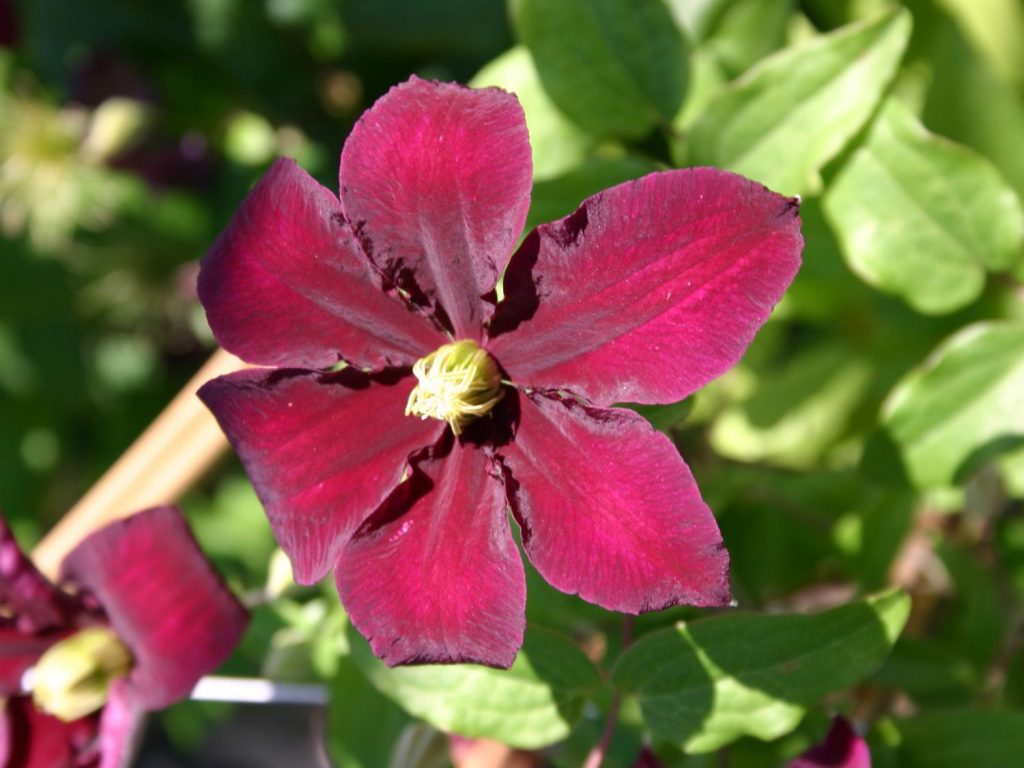
Clematis niobe
Carefully inspect the aerial part, it is important that the leaves and shoots are free of mechanical injuries and signs of disease. The buds should be juicy, green.
Clematis are usually sold in containers. When transplanted to a site, they are removed from the container, the roots are saturated with moisture by immersion in cold water for a couple of hours.
Then the roots are cut by 2-3 cm so that in the future they begin to grow new processes.
Landing technique
The pit is prepared in two weeks so that the soil and nutrients settle. The approximate dimensions are 40x50 cm.
Half the hole is filled with fertile soil mixture - the dug soil is mixed with humus (compost) and sand in a 1: 1: 1 ratio. To this mixture add 1 tbsp.superphosphate and potassium sulfate.
The root system is lowered, covered with the remaining earth to the top, watered, mulched with peat.
When planting clematis in the garden, it is important to prevent deepening of the root collar, which will negatively affect further survival and growth.
With a group planting, the distance between the bushes is maintained - at least 1 m.
Care requirements
Watering
In order for the seedling to take root faster, it is watered daily for 20 days. Use 3-4 liters of water.
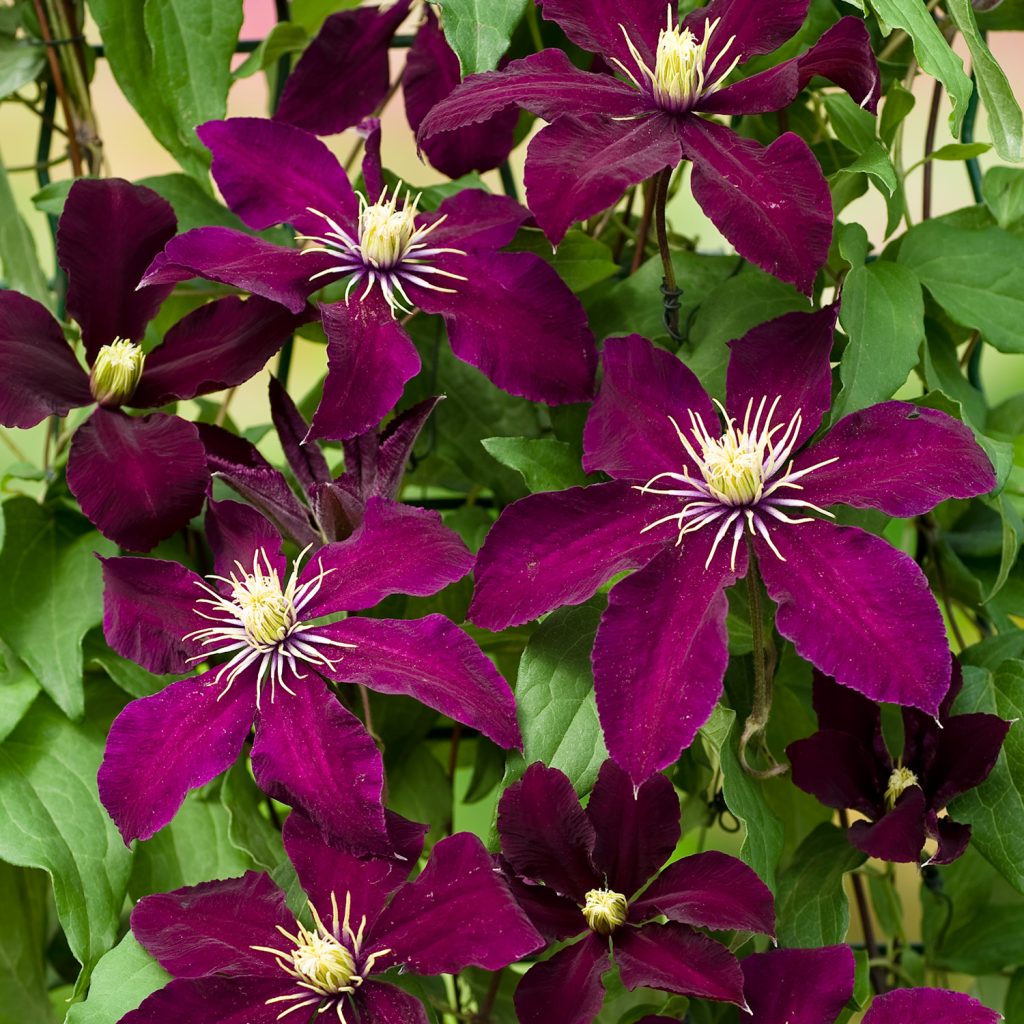
Niobe clematis
When it starts to grow, the frequency of moistening is reduced and is guided by the state of the surface layer of the earth (the soil must dry to a depth of 4-5 cm).
The water should be at room temperature to eliminate the risk of freezing and rotting of the roots.
In dry and hot seasons, the shrub must be irrigated periodically. This procedure is carried out in the evening, when the sun goes down, so as not to burn the foliage.
Loosening and mulching
So that a crust does not form on the surface of the soil, it is regularly loosened immediately after moistening. Together with this procedure, weeds are removed, the aisles are weeded. Then they add peat mulch, which will protect the soil from rapid drying out.
Top dressing
From the third year of life, Clematis Niobe needs to be fed. By this age, the planting nutrients will run out.
Nutrition is carried out in three stages:
- In early spring, before the onset of swelling of vegetative buds, they are watered with liquid organic fertilizers for decorative flowering vines. You can buy them at any gardening store. The dosage is indicated on the package.
- In the phase of budding and lush flowering, they feed with a complex composition that contains phosphorus, potassium and nitrogen.
- In the fall, when the shrub leaves the foliage and goes into a dormant period, compost or last year's manure is embedded in the near-trunk zone.
Each root nutrition is carried out in combination with irrigation, which improves and accelerates the process of assimilation of nutrient components.
Pruning
This variety of clematis belongs to the third pruning group. All flowers are formed on the new growth of the current year.
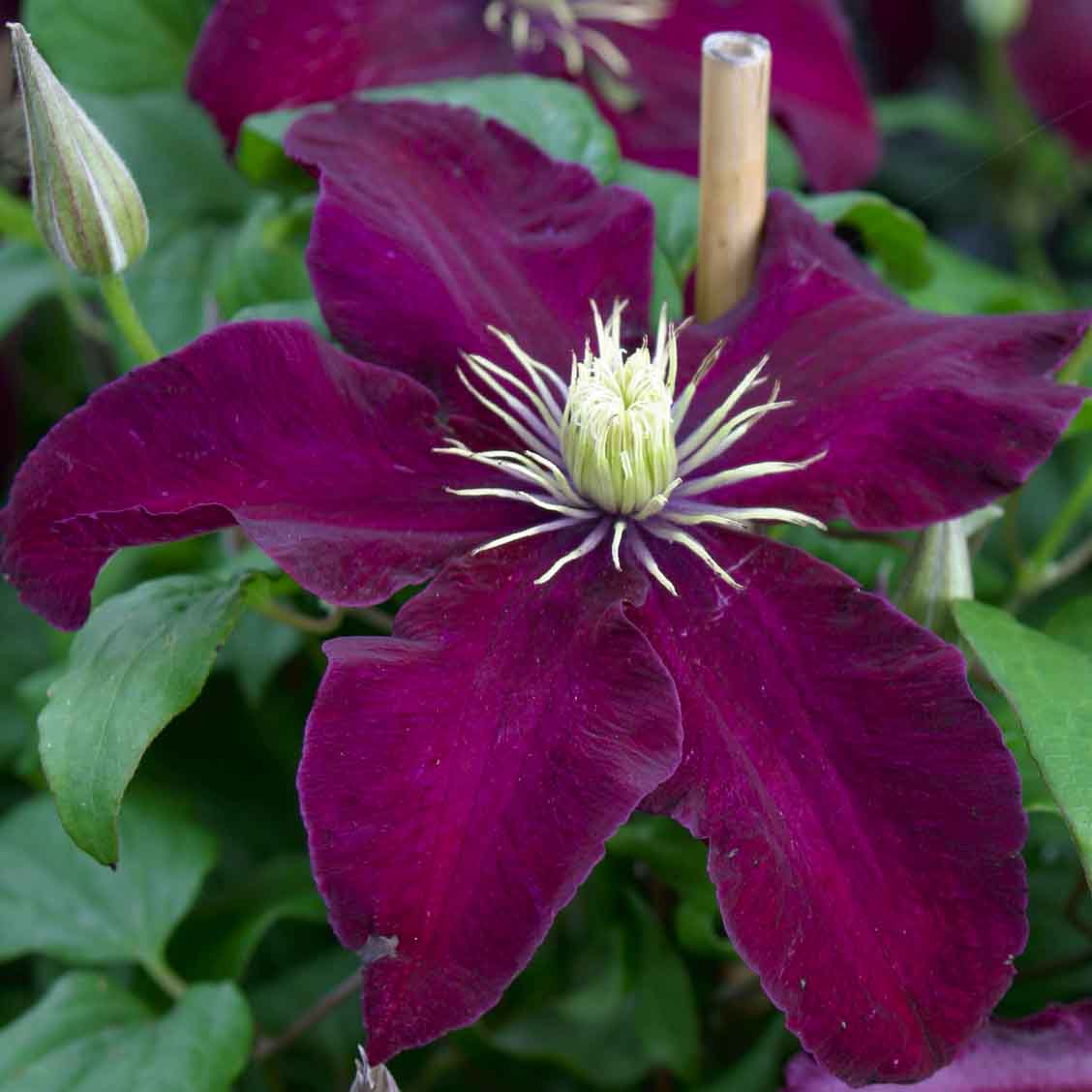
Niobe clematis trimming group
After leaf fall in autumn, young branches that have developed this season are pruned to 2-3 buds. The cut stems are sent to the compost heap, in the future they will become a nutritious fertilizer for the shrub.
Throughout the growing season, it is necessary to cut out diseased and non-viable parts that have turned yellow, dried out, frozen or broken off.
All manipulations are carried out using a sharp and sterile instrument. After pruning, the crown is irrigated with a solution of copper sulfate. It prevents the appearance of infections at the cut sites.
Preparing for winter
Almost all varieties of clematis have good frost resistance, and this variety is no exception. But at a young age, when grown in a harsh climatic zone, insulation will be required for 3 years.
Preparation for the winter begins a week before the upcoming frost:
- the trunk circle is spud with a thick layer of peat, humus or compost;
- branches are collected in a bunch, tied with a rope or twine, bent to the ground, fixed with staples;
- cover the aerial part with fallen leaves, then spruce branches.
They remove the shelter in the spring, when the snow thaws and the threat of return frosts has passed.
Reproduction methods
There are several ways to get new seedlings from the mother bush. Subject to all the rules, each method will give a positive result.
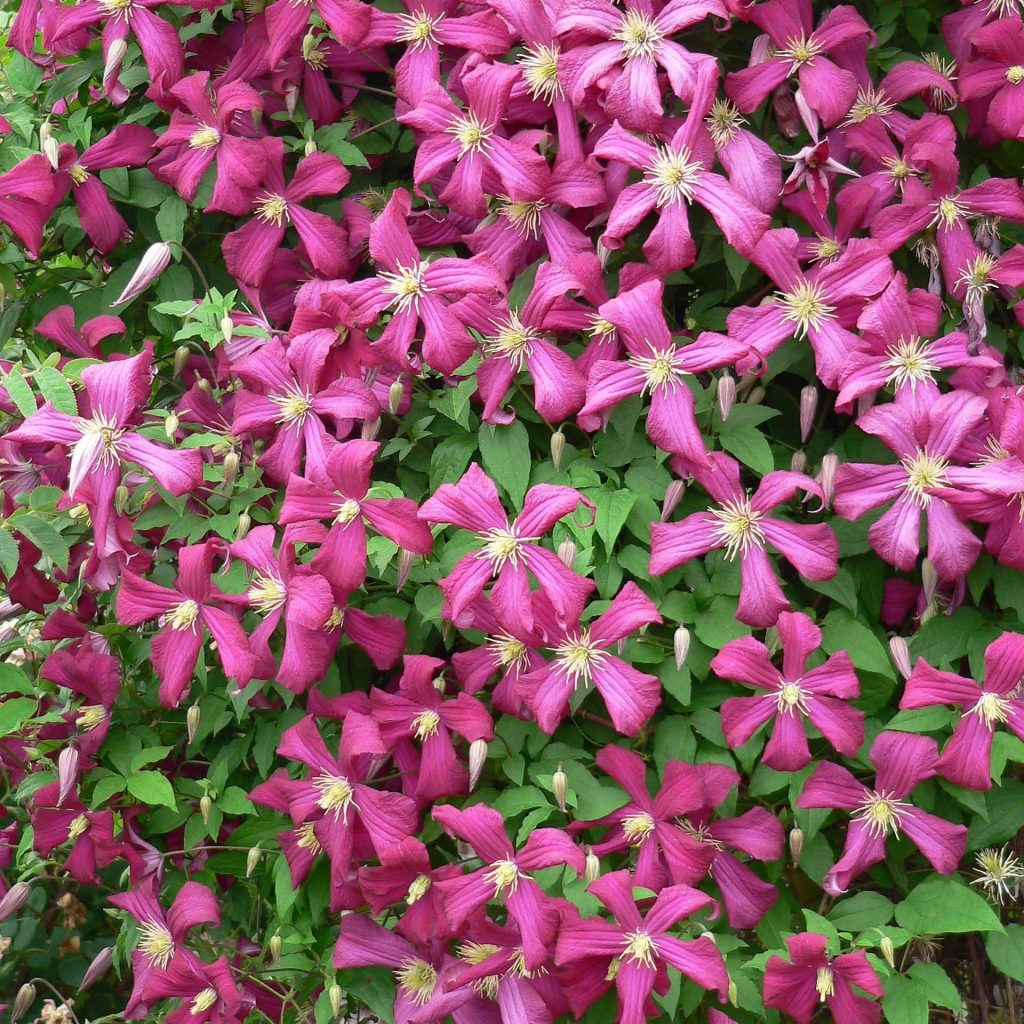
Clematis niobe trimming group
Stem layering
For such reproduction, a bush from 7 years old is suitable. Choose the most flexible shoot close to the soil. Remove all the leaves on it, bend to the ground, lay in a horizontal position.
Sprinkle with a mixture of peat, humus and sand, mixed in equal amounts, watered. A week before the first frost, they are covered with fallen leaves, then with spruce branches.
In the spring, when the snow melts, they remove the insulation, dig out a twig, cut it off from the bush. Divide into several parts so that each has roots.
Delenki are seated separately in fertile land in the same way as purchased plants.
By dividing the rhizome
This breeding is done in the spring. They use old bushes that have stunted their growth and need rejuvenation.
Clematis is watered abundantly, dug out, dipped in a bucket of water to wash off the remnants of the earth. The rhizome is dried, then cut into pieces with a garden shovel. Each delenka should have one shoot with several roots.
Places of cuts are treated with a solution of copper sulfate, powdered with charcoal. They are seated separately in a flower bed or in a flower garden.
Cuttings
Cutting of planting material is carried out in spring or summer. Select stems of the current year with multiple buds. The optimal length of the segments is 12-15 cm.
At the bottom, the leaves are cut off, then dipped into Kornevin's solution for an hour. For planting shoots, a seedling box or a plastic container with drainage holes filled with a peat-sand mixture is suitable.
The cuttings are deepened by 3-4 cm, poured with warm water, covered with a transparent film. They are placed in a warm and well-lit place where the temperature fluctuates between 22-25 ° C. Ventilate every day, moisten as the substrate dries.
As soon as they start to release new leaves, the shelter is removed. They continue to look after for another month so that they become overgrown with roots, then they are planted on the site.
Diseases and pests
Infection with diseases and parasites is possible only if the rules of care and maintenance are violated:
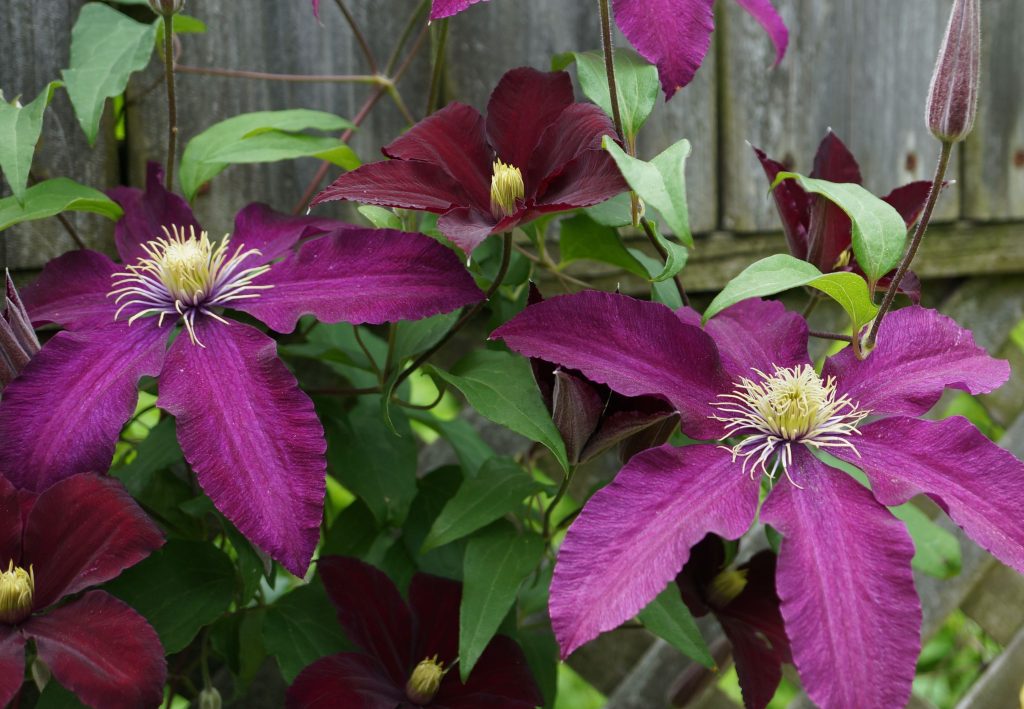
Clematis niobe photos
- Rust. It can be identified by red or brown shapeless growths on leaves and stems. Infected places darken, then die off and crumble. Treatment is carried out using chemistry - first, diseased areas are cut out, the crown is irrigated with Ridomil Gold, Skor or Hom.
- Powdery mildew. The causative agent is a fungus. Appears in wet and rainy weather. Looks like a white bloom on foliage, shoots. Over time, it darkens, the diseased parts die off. First, you need to cut out the infected areas, then irrigate the crown with chemical agents - Bordeaux liquid or copper sulfate.
- Chlorosis of the leaves. This sore affects shrubs with a lack of iron in the soil. You can correct the situation if you feed the vine with chelating drugs.
- Aphid. The insect multiplies rapidly and settles on the inside of the leaves. It feeds on their juice, which leads to wrinkling, yellowing and shedding. At the initial stage of infection, you can do without chemistry - irrigate the crown with infusion of tobacco, garlic or a solution based on laundry soap and ash. The neglected form is treated with pesticides - they are treated with Fitoverm or Karbofos.
- Caterpillars. They gnaw holes in the leaves, as a result of which the shrub slows down growth, loses its original decorative effect. Without timely treatment, only stems may remain on the bush. Treatment with insecticides is required - Aktellik, Fitoverm.
- Nematode. A small insect damages the root system of the plant, as a result, it ceases to receive moisture and nutrients. Necrosis of the aerial part develops. With such a lesion, clematis cannot be saved, so it is dug up, burned, and the place of growth is spilled with a raspberry solution of potassium permanganate or copper sulfate.
- Spider mite. Appears in extreme heat and drought. Therefore, for prevention these days, you need to spray the crown. The infected vine is treated with insecticides - Aktellik or Aktara.
To protect against damage by diseases and pests, it is necessary to buy healthy bushes and keep the site clean - remove fallen leaves on time, remove weeds, regularly loosen the soil and cut off non-viable parts.
Application in design
The decorative and lush blooming liana has gained great popularity in modern floriculture:
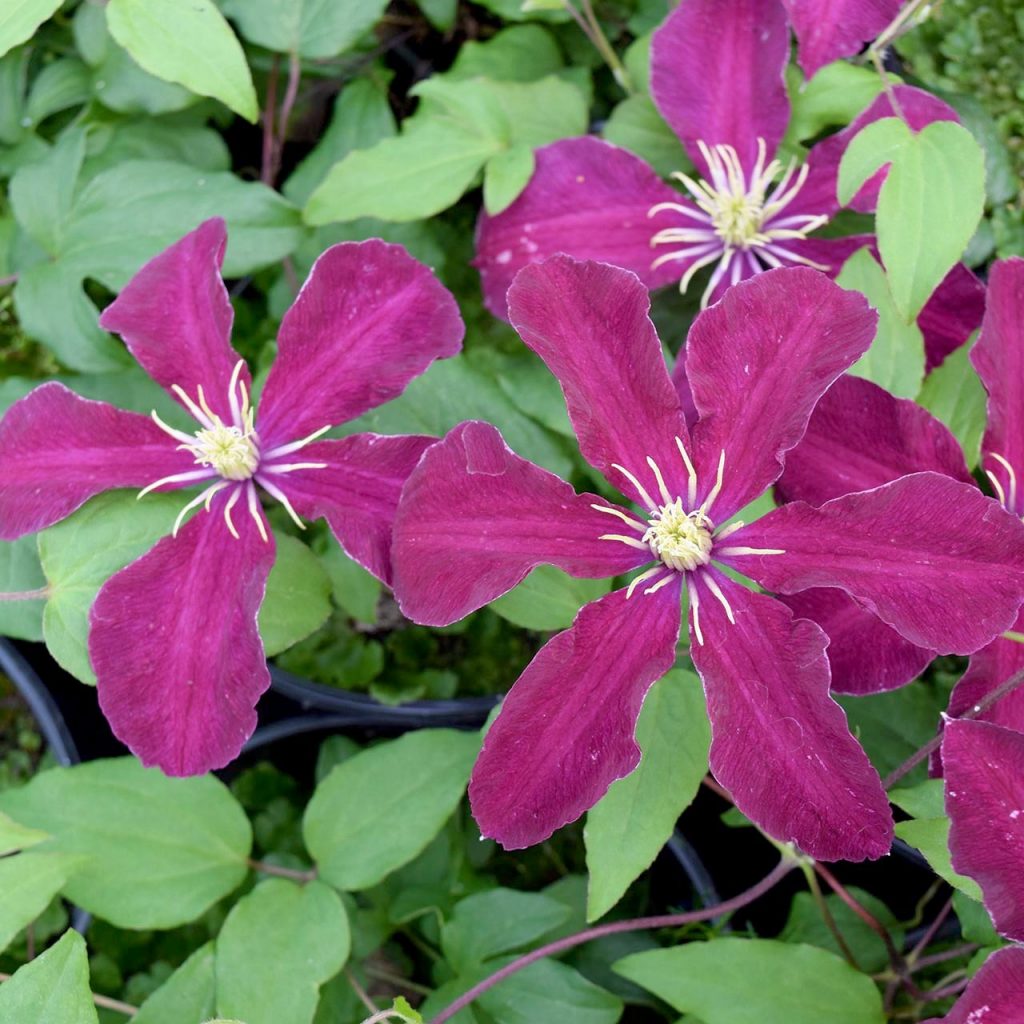
Clematis niobe variety description
- it is planted near arches, gazebos, terraces;
- used to decorate vertical structures and surfaces - pergolas, pillars, dead trees;
- planted along fences in groups, creating a bright hedge;
- combine with other varieties to create a multi-colored composition in the garden.
Variety reviews
Thanks to its unpretentious care, bright and long flowering, many growers love this variety and give it only a positive characteristic:
- the plant has good frost resistance, grows well on different types of soils, which allows it to be successfully grown throughout the territory of our country;
- under good growing conditions, it is practically not exposed to infection and pest infestation;
- it reproduces in several ways, which makes it possible to independently grow several seedlings with all the varietal characteristics of the mother bush.

